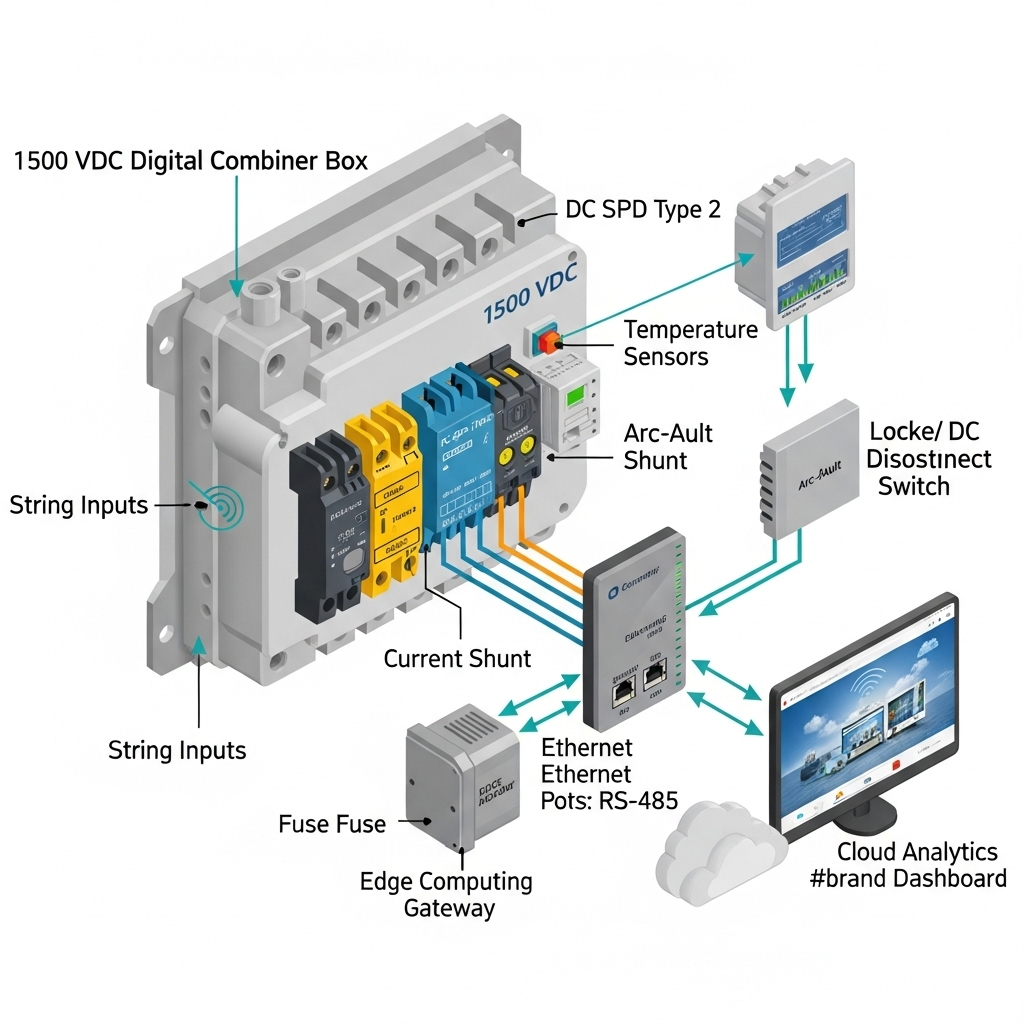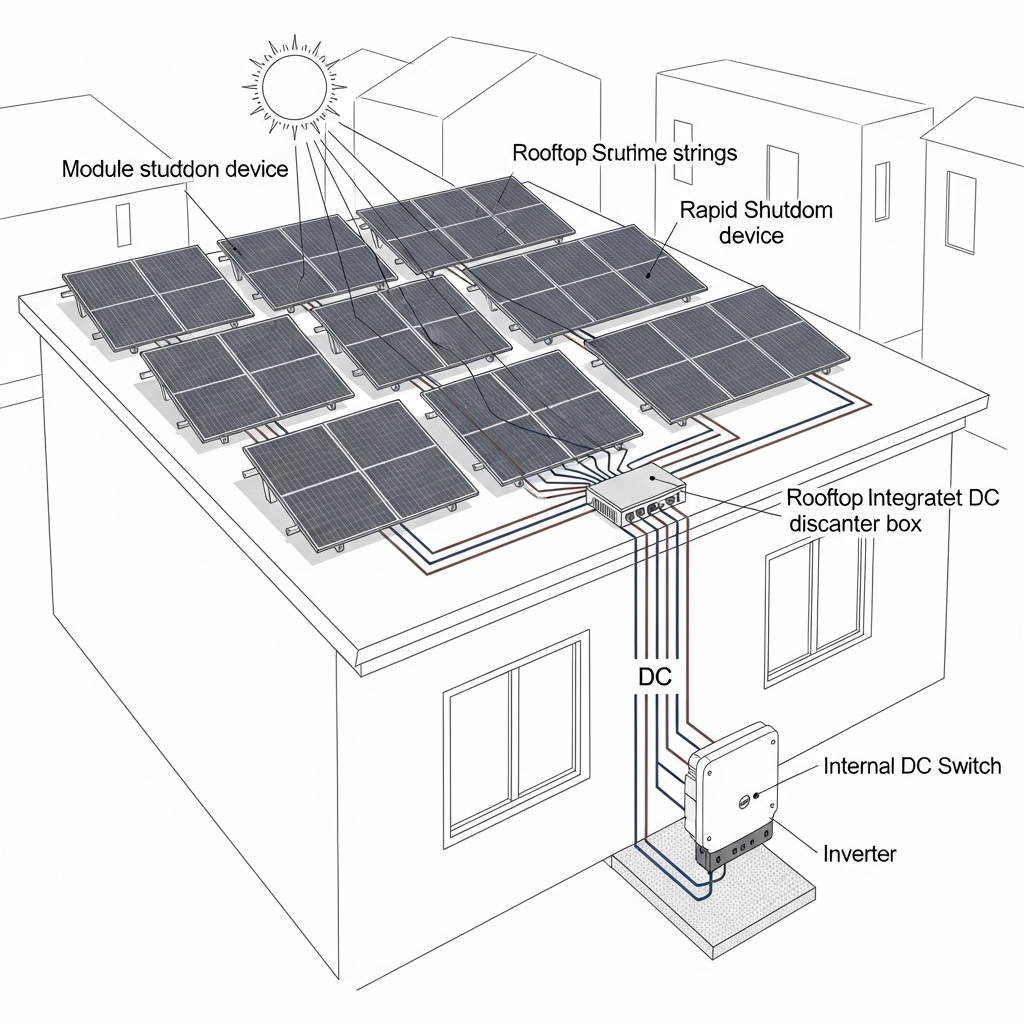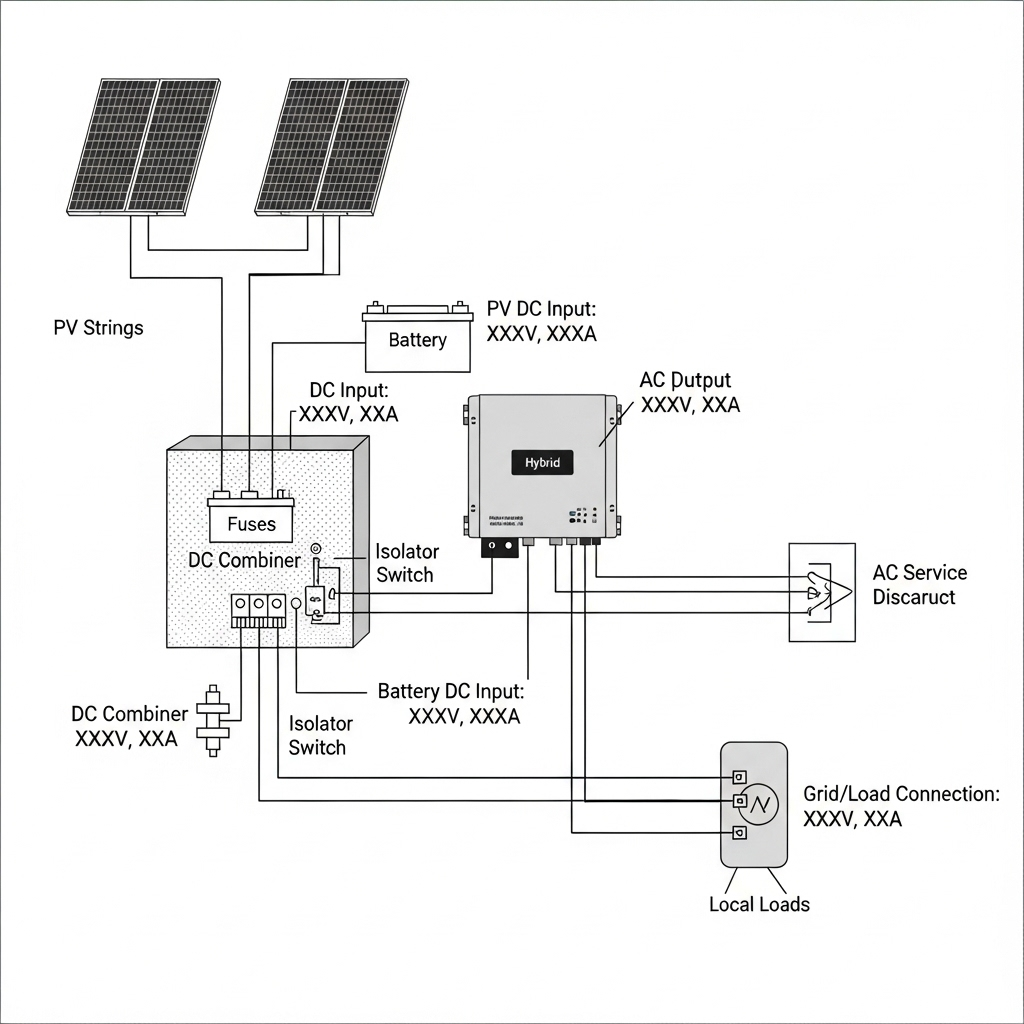String-level data is becoming the new baseline for utility and C&I solar. In 2025, digital combiner boxes and combiner box analytics will move from nice-to-have to standard on new 1000 V and 1500 V arrays. The payoff is higher yield, faster troubleshooting, and stronger safety through smarter isolators and disconnects.
Falling PV costs and maturing storage set the stage. According to IRENA’s Renewable Power Generation Costs in 2024, utility-scale solar continued its cost decline through 2024, improving the business case for advanced BoS digitalization. IRENA also notes a growing set of hybrid projects and shows that solar+wind systems tend to post lower LCOE than configurations that add storage, while still highlighting the rapid build-out of PV-plus-BESS worldwide. Their database covers four hybrid types across about 10 GW of projects commissioned in 2023–2024, with top markets in the United States, China, India, and Australia.
Why digital combiner boxes lead 2025 designs
More data, more uptime
Digital combiner boxes bring real-time visibility to every string. Onboard sensors track string current and voltage, busbar temperature, enclosure humidity, SPD health, and isolator/disconnect status. With this data, analytics can flag soiling, shade, loose terminations, blown fuses, and incipient arc-risk conditions early. The result is fewer site visits and faster ticket closure.
Downstream value with AI-ready data
The rise of AI in energy is accelerating data use across assets. The IEA’s Energy and AI report highlights the sector’s rapid uptake of machine learning for forecasting and predictive maintenance. Digital combiner boxes are the first-mile data source that feeds those models with timestamped, string-level signals.
Cost backdrop favors digitalization
As module and EPC costs have fallen, owners are reallocating budget to asset intelligence. IRENA documents sustained reductions in utility-scale PV LCOE through 2024, with balance-of-system improvements a key lever. That context supports targeted upgrades such as analytics-ready PV combiner boxes.
Key features to request in 2025 PV combiner boxes
String sensing and edge computing
- Per-string shunts or Hall sensors rated for 1500 VDC with ±1% accuracy.
- Sampling at 1–10 s intervals for timely alarms without flooding the network.
- Local edge processor for thresholding, event compression, and secure buffering during network loss.
- Time sync via NTP or GPS to align events across inverters, trackers, and BESS.
Built-in safety: isolators, disconnects, and arc vigilance
- Lockable DC isolator/disconnect, load-break rated at system voltage (1000 V or 1500 V), coordinated with fuse clearing times.
- Type 1/2 surge protective device with remote status contact and thermal disconnector.
- Temperature sensors on busbars and terminations; alarms for abnormal rise, supporting preventive maintenance.
- Arc-fault detection module where required by local code; pair with clean cable management and torque logs.
Interoperability and cybersecurity
- Protocols: Modbus RTU/TCP, SunSpec signal mapping, and optional IEC 61850 in large plants.
- Security: TLS encryption, role-based access control, signed firmware, and audit logs.
- Northbound integration to SCADA, EMS, or cloud via MQTT/HTTPS with store-and-forward.
For safety practice and code context, the U.S. Department of Energy solar energy resources summarize common measures used with PV equipment, including disconnect placement, labeling, and maintenance intervals. Always apply local electrical codes and standards.
Analytics that pay for themselves
High-impact diagnostics
- Soiling and shade: Compare string currents across similar orientations to estimate soiling rate and trigger optimized cleaning schedules.
- Fuse and connector health: Detect current imbalance, thermal rise, or intermittent dropouts that signal loose terminations.
- Inverter clipping or MPPT mismatch: Identify strings consistently off the fleet average under identical irradiance windows.
- SPD life monitoring: Alert on MOV end-of-life events to avoid hidden protection gaps.
Predictive maintenance and dispatch
With 12+ months of string-level data, anomaly detection finds slow-degrading strings. Paired with weather and inverter logs, O&M teams can batch work orders and reduce truck rolls. This aligns with the data-centric approach showcased in the IEA Energy and AI work, which underscores the productivity boost from well-structured datasets.
ESS-aware insights
Digital combiner boxes also strengthen PV-to-BESS coordination. The piece Ultimate Reference: Solar Storage Performance summarizes practical ranges for round-trip efficiency and battery care. It notes that LiFePO4 systems typically deliver round-trip efficiency in the mid-80s to low-90s, subject to inverter topology and temperature. It also highlights how moderating depth of discharge and avoiding high-C bursts extends cycle life. Feeding accurate PV production profiles from the combiner improves charge windows and reduces unnecessary cycling.
2025 specification checklist
Electrical ratings and coordination
- System voltage: Specify 1500 VDC capability for new builds unless constrained by legacy assets.
- String fusing: Size fuse links to module Isc and string count; verify let-through energy and temperature derating.
- Short-circuit current rating (SCCR): Verify enclosure SCCR meets fault levels at the point of interconnection.
- Isolator/disconnect: Verify load-break DC rating at full voltage; confirm padlockable handle and visible open where required.
Environmental and mechanical
- Enclosure: NEMA 4X or IP65+ with UV-stable gaskets for harsh sites; include drain/vent plugs to manage condensation.
- Thermal design: Allow margin for 50–60°C ambient; validate busbar and fuse temperature rise under worst-case current.
- Cable entries: Gland plates sized for conductor classes; maintain bend radius and segregation for communication wiring.
Data and integration
- Sensor accuracy: ≤1% for current, ≤0.5% for voltage to support bankable KPIs such as Performance Ratio.
- Logging: 1–10 s sampling; 8–24 hours of local buffering during outages.
- Northbound mapping: Provide tag list and data dictionary aligned to SCADA/EMS naming conventions.
Analog vs digital combiner boxes in 2025
| Category | Analog combiner | Digital combiner (2025) |
|---|---|---|
| CapEx delta | Baseline cost | +5–12% per MW (sensors, edge, SPD upgrade) |
| Fault localization | Tracker/inverter level | String level, typical time cut by 60–90% |
| Yield impact | Reactive O&M | +0.5–2.0% annual energy via soiling and outage control |
| Safety insight | Manual checks | Live isolator status, busbar temp, SPD health, arc alerts |
| Data readiness | Limited | SCADA/EMS-ready with secure APIs |
Cost and benefit ranges vary by site, climate, and staffing. Use your own O&M rates to localize ROI. For market context, the U.S. EIA continues to report rising distributed PV capacity, magnifying the value of streamlined diagnostics at scale.
Safety, codes, and bankability
Combiner boxes are part of a safety chain that includes proper disconnects, fusing, labeling, and surge protection. Coordinate equipment with relevant standards (for example, IEC 61439 for assemblies and IEC 60947-3 for switches/isolators) and your local electrical code. The DOE solar energy pages provide accessible safety primers and references used by many teams. Always confirm site-specific requirements with your AHJ and EPC. This section is informational only and does not constitute legal advice.
PV, storage, and isolators/disconnects: getting the handoff right
In hybrid or DC-coupled plants, clear separation and safe isolation are critical. Place lockable DC isolators near the combiner’s incoming and outgoing feeders so technicians can de-energize sections for work. For AC-coupled sites, coordinate combiner alarms with the EMS to avoid charging the BESS on faulty strings.
The IRENA cost analysis also discusses hybrid configurations and notes that solar+wind without storage tends to achieve lower LCOE than options that include batteries. That said, storage adds flexibility. The Solar Storage Performance reference highlights how LiFePO4 performance holds up well at moderate temperatures, with round-trip efficiency often above the mid-80s. Using accurate PV string data to match charge windows to irradiance peaks reduces BESS throughput and heat, which helps preserve cycle life.
Practical deployment tips for 2025
- Commissioning: Record baseline IV snapshots per string under stable irradiance. Store in the asset’s data room for future comparisons.
- Alarm discipline: Start with a tight set of rules (fuse trip, SPD end-of-life, temp rise). Add advanced analytics once noise is under control.
- Cleaning policy: Use combiner analytics to trigger cleaning only where soiling actually depresses production beyond your threshold.
- Cyber hygiene: Rotate credentials, enable signed firmware, and segment OT networks. The IEA Energy and AI work stresses robust data governance as AI scales.
- Spare strategy: Stock fuses, SPD modules, and isolator handles compatible with your installed base to minimize downtime.
What the data says about 2025
Public agencies show a clear macro signal: more PV, more hybrid systems, and faster learning curves. IRENA attributes falling PV LCOE to ongoing module and BoS improvements. Their hybrid project sample across 2023–2024 totals about 10 GW, underscoring the relevance of data-rich BoS. The IEA emphasizes the expanding role of AI for forecasting and maintenance. The EIA continues to publish detailed generation and capacity trackers that reflect PV scale-up in the United States. Together, these points support a 2025 pivot toward digital combiner boxes with analytics and safer isolators/disconnects.
Final take
Digital combiner boxes are becoming the default choice. In 2025, expect most new 1500 V arrays to specify string-level sensing, edge analytics, and secure connectivity, paired with robust DC isolators and disconnects. Owners gain measurable yield, fewer truck rolls, and cleaner safety records. Teams building PV-plus-storage should also incorporate the storage care practices shared in the Ultimate Reference: Solar Storage Performance to turn high-quality PV data into longer battery life.
Financial and code disclaimer: Performance, ROI, and compliance outcomes vary by site, tariff, and regulation. This content is not financial or legal advice.
FAQ
What is a digital combiner box?
A digital combiner box aggregates multiple PV strings and adds sensors, edge computing, surge protection, and a lockable DC isolator/disconnect. It streams data to SCADA or cloud analytics for faster fault detection and better O&M.
Do digital combiner boxes make sense for small sites?
Yes, especially for remote or labor-constrained assets. The ability to pinpoint faults and verify isolator status can offset the added hardware cost through fewer truck rolls.
How do isolators and disconnects fit into the design?
They provide safe, visible isolation for maintenance. Choose DC-rated, load-break devices at system voltage, and position them so crews can de-energize sections without ambiguity.
Will analytics reduce battery wear in hybrid plants?
Accurate PV string data improves charge scheduling. As outlined in the Solar Storage Performance reference, minimizing unnecessary cycling and avoiding high-C bursts help preserve LiFePO4 life.
Which standards should I check?
Coordinate with your local electrical code and relevant equipment standards (for example, IEC 61439 for assemblies and IEC 60947-3 for switches/isolators). For introductory safety resources, see the U.S. DOE solar energy pages.





Leave a comment
All comments are moderated before being published.
This site is protected by hCaptcha and the hCaptcha Privacy Policy and Terms of Service apply.